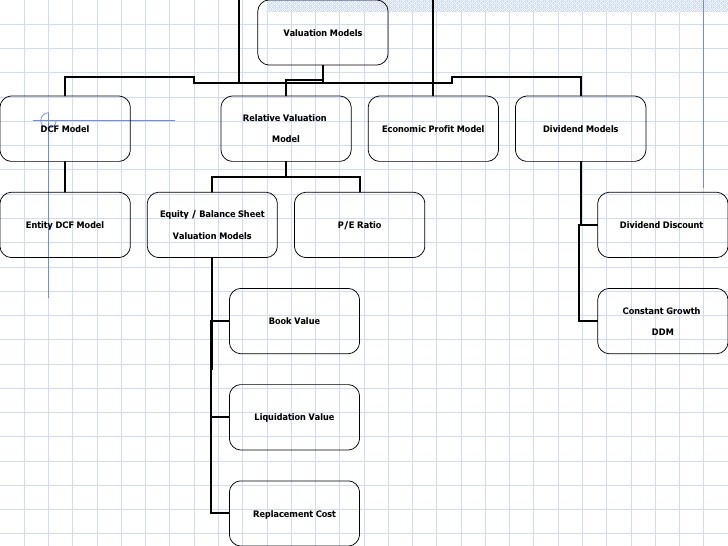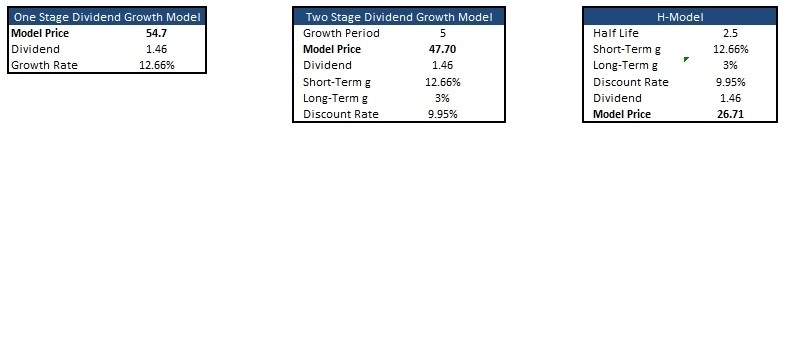Gordon Dividend Discount Model (DDM) versus FCF Valuation Model
Post on: 23 Июнь, 2015 No Comment

to shareholders
KE = Cost of equity
g = growth rate of net income
VE = Value of equity
What becomes immediately clear when comparing these two models is that D0 must equal FCFS0 for these two models to both be correct. Let’s first completely define these two models, then come back to the question of what it takes for these two models to equal.
For both models, the cost of equity (KE ) can be derived via the CAPM model (see other blog posts for details regarding CAPM), and the growth rate of net income equals the retention ratio multiplied by the ROE:
Where:
RFR = Risk-Free-Rate, current 30-yr T-Bond rate
MRP = Market Risk Premium, historic spread between the S&P 500 and the RFR
β = Slope between linear fit of real yields (inflation adjusted and w/ dividends) of
S&P 500 (x-axis) against firm’s stock (y-axis)
And for both models the Net Income growth rate (g) is the same, and can be derived from the following equation:
Where:
RR = One minus the Dividend Payout Ratio (1-PR)
PR = Dividend Payout Ratio which equals ( D0 / Net Income0 )
ROE = Return on Equity which equals ( Net Income0 / Book Equity0 )
Remember that Book Equity includes the par value of common stock, additional paid-in capital for common stock, and retained earnings. Also, the subscripts of zero imply current values.
The Dividends being paid out (D0 ) comes from Net Income, with this defining the PR, RR, and thus the growth rate of the firm.
So what is FCFS0. and where does it come from? It is defined by the following formula:
+Depreciation and Amortization (DA)
-Capital Expenditures (CapEx)
-Change in Net Operating Working Capital (ΔNOWC)
-Debt Principal Payments
+New Debt Issuances

As you can see, it is also Net Income based, and adjusts for DA since these are not cash flows, and adjusts for CapEx and the ΔNOWC, and then adjusts for cash being paid out and received by the debt holders, because this is money directly available to the shareholders. All of these adjustments are the equivalent of a retention ratio, and will determine the growth rate of the firm. What FCFS0 truly represents then, is the cash that is available for payout to the shareholder, and this is the equivalent then of the dividend assuming that all cash available for payout is paid as a dividend to the shareholder.
If the reinvestment in the firm is reflected in the growth rate of Net Income. and if all of the FCFS0 is paid out to the shareholder, then the DDM and FCFS0 should equal. If the firm chooses to not pay out all of its FCFS0 to its shareholders, then this will accumulate on the balance sheet in the form of excess cash and marketable securities, which would then need to be subtracted from the VE obtained via the FCFS0 model for it to equal the DDM model’s VE . It is subtract because this implies that the dividend is not at 100% of FCFS0. so the DDM model will produce a lower value.
Another method for calculating the FCFS0 is to realize that the firm has a set debt ratio δ (i.e. [debt / (debt + equity)] ). This means that the adjustments for the payment and issuance of debt can be replaced by the ongoing debt ratio via the following formulas:
Where:
δ = Debt ratio
D = Book debt value
E = Book equity value
If the firm has been in the practice of buying back stock and/or adjusting their capital structure by buying back stock via the issuance of new debt, then the dividend is not an accurate payout measure, and an adjusted payout ratio should be applied. This will have direct ramifications on the growth rate as well, and will impact the DDM model.
This adjusted PR should be applied to the DDM model in an identical fashion as our original PR was applied. Note that FCFS0 does not have to be paid out as a dividend, but could be paid out in the form of a stock buyback as well, so the FCFS0 and DDM models are once again in unison.
If excess cash and marketable securities have been allowed to build on the balance sheet as a result of FCFS0 not being returned to the shareholders, then the ROE should be adjusted a swell to only reflect true return due to operations and not investments.
Also note that in this case, the Dividend ( D0 ) would instead equal the dividend paid out plus the stock repurchased.
Click here for a PDF download of this post: DDM vs. FCFE
This post is based on theory and models originally derived by Aswath Damodaran from NYU.














